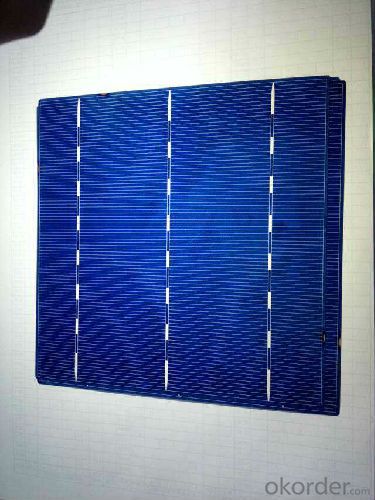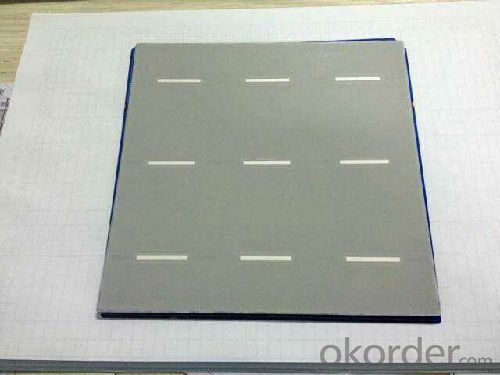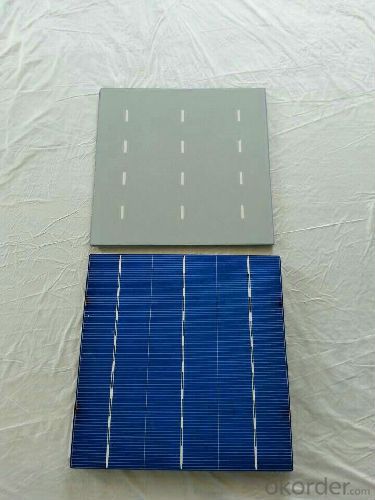Solar Cells Poly 3BB with Lower Price AB Grade
- Loading Port:
- Shanghai
- Payment Terms:
- TT or LC
- Min Order Qty:
- 30000 pc
- Supply Capability:
- 1000000 pc/month
OKorder Service Pledge
OKorder Financial Service
You Might Also Like
Electrical Characteristic
Efficiency (%) | Pmpp (W) | Umpp (V) | Impp (A) | Uoc (V) | Isc (A) | FF (%) |
17.25 | 4.197 | 0.524 | 7.992 | 0.62 | 8.458 | 80.03% |
17 | 4.137 | 0.524 | 7.876 | 0.619 | 8.353 | 80.01% |
16.75 | 4.076 | 0.522 | 7.81 | 0.617 | 8.286 | 79.73% |
16.5 | 4.015 | 0.518 | 7.746 | 0.613 | 8.215 | 79.73 |
16.25 | 3.955 | 0.515 | 7.683 | 0.61 | 8.144 | 79.61% |
16 | 3.894 | 0.512 | 7.613 | 0.608 | 8.075 | 79.31% |
15.75 | 3.833 | 0.51 | 7.534 | 0.605 | 8.058 | 78.62% |
15.5 | 3.772 | 0.508 | 7.453 | 0.604 | 8.02 | 77.87% |
15.25 | 3.771 | 0.505 | 7.35 | 0.604 | 9.997 | 76.83% |
15 | 3.65 | 0.503 | 7.271 | 0.604 | 7.989 | 75.64% |
14.5 | 3.529 | 0.499 | 7.067 | 0.604 | 7.988 | 73.14% |
14 | 3.407 | 0.499 | 6.833 | 0.604 | 7.833 | 72.01% |
Intensity Dependence
Intensity [W/m2] | Isc× [mA] | Voc× [mV] |
1000 | 1.00 | 1.000 |
900 | 0.90 | 0.989 |
500 | 0.50 | 0.963 |
300 | 0.30 | 0.939 |
200 | 0.20 | 0.920 |



Advantage Of Poly Solar Cell 156mm
1: High quality cell, Level A cell (14%—17.5%)
2.Dimensione:156*156mm Diagonal:200mm
3: Qualified certification: TUV,CE certification.
4: Warranty: five years for whole unit
Photovoltaic cells are made of special materials called semiconductors such as silicon, which is currently used most commonly. Basically, when light strikes the cell, a certain portion of it is absorbed within the semiconductor material. This means that the energy of the absorbed light is transferred to the semiconductor. The energy knocks electrons loose, allowing them to flow freely. The third generation of solar cells includes a number of thin-film technologies often described as emerging photovoltaics—most of them have not yet been commercially applied and are still in the research or development phase. Many use organic materials, often organometallic compounds as well as inorganic substances. Despite the fact that their efficiencies had been low and the stability of the absorber material was often too short for commercial applications, there is a lot of research invested into these technologies as they promise to achieve the goal of producing low-cost, high-efficiency solar cells.
- Q:How is the efficiency of a solar cell calculated?
- The efficiency of a solar cell is calculated by dividing the maximum power output of the cell by the input power from the sunlight.
- Q:How do solar cells perform in regions with frequent thunderstorms?
- Solar cells perform less efficiently in regions with frequent thunderstorms. Thunderstorms often bring heavy cloud cover and reduced sunlight, which significantly impacts the generation of solar energy. Additionally, the presence of lightning poses a risk to the solar panels themselves, potentially damaging or destroying them. Therefore, regions with frequent thunderstorms may not be ideal for solar energy production.
- Q:Can solar cells be used in desert environments?
- Yes, solar cells can be used in desert environments. In fact, desert regions are ideal for solar energy production due to the high amount of sunlight available. The arid climate and lack of cloud cover in deserts contribute to optimal solar panel performance, making them efficient in generating electricity. Additionally, the vast open spaces in deserts provide ample land for large-scale solar power plants.
- Q:Can solar cells be used to power electronic devices?
- Yes, solar cells can be used to power electronic devices. Solar cells convert sunlight into electricity, which can be used to power a wide range of electronic devices such as calculators, smartphones, and even household appliances.
- Q:Can solar cells be used for powering electric vehicles charging stations?
- Yes, solar cells can be used for powering electric vehicle charging stations. This is known as solar-powered charging infrastructure, which utilizes solar panels to convert sunlight into electricity, which is then used to charge electric vehicles. This approach provides a sustainable and renewable energy source for EV charging, reducing reliance on non-renewable energy sources and decreasing environmental impact.
- Q:Can solar cells be used on windows?
- Yes, solar cells can be used on windows. Photovoltaic (PV) technology allows solar cells to be integrated into windows, transforming them into transparent solar panels. These solar windows can generate electricity from sunlight while still maintaining the functionality of a regular window. They are being increasingly used in buildings to harness solar energy and contribute to sustainable energy solutions.
- Q:How do solar cells impact the local economy?
- Solar cells can have a positive impact on the local economy in several ways. Firstly, the installation and maintenance of solar panels create job opportunities, stimulating employment and income growth within the community. Additionally, solar energy reduces the reliance on imported fossil fuels, leading to reduced energy costs for local businesses and residents. This, in turn, frees up funds that can be reinvested in the local economy, fostering economic development. Moreover, solar power can also generate revenue for local governments through tax incentives and property value increases. Overall, solar cells contribute to a more sustainable and prosperous local economy.
- Q:Can solar cells be used for powering remote weather stations?
- Yes, solar cells can be used for powering remote weather stations. Solar cells convert sunlight into electricity, which can be stored in batteries for use when sunlight is not available. This makes them a reliable and sustainable power source for remote locations where access to the electrical grid may be limited. Additionally, solar cells are low maintenance and can operate for long periods without human intervention, making them an ideal choice for powering weather stations in hard-to-reach areas.
- Q:Can solar cells be used to power surveillance cameras?
- Yes, solar cells can be used to power surveillance cameras. Solar power provides a reliable and sustainable energy source for surveillance systems, making them independent of the electrical grid. This allows cameras to be placed in remote locations or areas without access to electricity, while still maintaining continuous operation.
- Q:Are solar cells durable?
- Yes, solar cells are generally durable. They are designed to withstand various environmental conditions such as heat, humidity, and extreme temperatures. Additionally, most solar cells are made with materials that have a long lifespan and are resistant to degradation. However, proper maintenance and protection are necessary to ensure their longevity.
1. Manufacturer Overview |
|
|---|---|
| Location | |
| Year Established | |
| Annual Output Value | |
| Main Markets | |
| Company Certifications | |
2. Manufacturer Certificates |
|
|---|---|
| a) Certification Name | |
| Range | |
| Reference | |
| Validity Period | |
3. Manufacturer Capability |
|
|---|---|
| a)Trade Capacity | |
| Nearest Port | |
| Export Percentage | |
| No.of Employees in Trade Department | |
| Language Spoken: | |
| b)Factory Information | |
| Factory Size: | |
| No. of Production Lines | |
| Contract Manufacturing | |
| Product Price Range | |
Send your message to us
Solar Cells Poly 3BB with Lower Price AB Grade
- Loading Port:
- Shanghai
- Payment Terms:
- TT or LC
- Min Order Qty:
- 30000 pc
- Supply Capability:
- 1000000 pc/month
OKorder Service Pledge
OKorder Financial Service
Similar products
New products
Hot products
Hot Searches
Related keywords



























